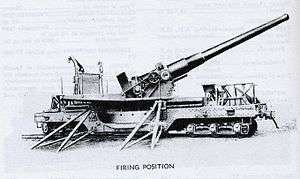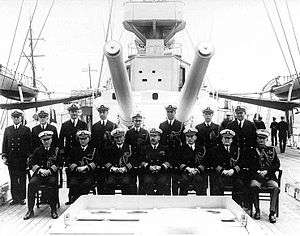8"/45 caliber gun
| 8"/45 caliber Mark 6 | |
|---|---|
|
USS Rochester (CA-2), ex-USS New York (ACR-2), forward 8"/45 Mark 12 turret in 1932. | |
| Type | |
| Place of origin |
|
| Service history | |
| In service | 1906 |
| Used by | |
| Wars | |
| Production history | |
| Designer | Bureau of Ordnance |
| Designed | 1900 |
| Manufacturer | U.S. Naval Gun Factory |
| Number built | 148 (Nos. 108–255) |
| Variants | Mark 6 Mod 1 – Mod 4 |
| Specifications | |
| Weight |
|
| Length | 369 in (9,400 mm) |
| Barrel length | 360 in (9,100 mm) bore (45 calibers) |
|
| |
| Shell |
|
| Caliber | 8 in (203 mm) |
| Recoil | 28.5 in (720 mm) max |
| Elevation |
|
| Traverse |
|
| Rate of fire | 1 to 2 rounds per minute |
| Muzzle velocity |
|
| Effective firing range |
|
The 8"/45 caliber Mark 6 gun (spoken "eight-inch-forty-five--caliber") were used for the secondary batteries of the United States Navy's last pre-dreadnought battleships and refitted in older armored cruisers main batteries.[1]
Design
The 8-inch (203 mm)/45 caliber gun was developed after the Spanish-American War to use the new smokeless powder that had recently been adopted by the Navy. This gun was much stronger than its predecessor, the 8-inch/40 caliber gun,[1] which were incapable of handling the new powder. This was shown when the muzzle of one of Colorado's guns blew off on 22 June 1907, during gunnery practice off Shantung.[2] The Mark 6, gun Nos. 108 – 255, 148 in total, was constructed of tube, jacket, four hoops a locking ring and the liner with a Welin breech block. These were all constructed of nickel steel. There were a tolal of eight different Mods, Mark 6 Mod 0 to Mark 6 Mod 7, with different liners, breech mechanisms, chambers, and rifling being used.[1][3]
Service history
The guns mounted in the Virginia-class battleships were in an unusual two-level turret with the 8-inch guns on top of the larger 12-inch (305 mm) guns. This arrangement ultimately proved unsuccessful but helped the Navy in the successful development of superfiring turrets later used in the dreadnought South Carolina.[1][3]
Due to an older 8-inch/40 caliber Mark 5s muzzle blowing off during gunnery practice in Colorado on 22 June 1907, all Mark 5s were removed from service, rebuilt, and placed in reserve. Because of this, all Pennsylvania-class armored cruisers and the armored cruiser New York, were refit with the newer Mark 6 guns.[2][3]
With the signing of the Washington Naval Treaty, the pre-dreadnoughts still in service were required to be scrapped. This surplussed up to 48 guns, which the Army used for coastal artillery, using new mountings and new lighter, and more streamlined, projectiles.[1][3]
Naval Service
| Ship | Gun Installed | Gun Mount |
|---|---|---|
| USS Virginia (BB-13) | Mark 6: 8"/45 caliber |
|
| USS Nebraska (BB-14) | Mark 6: 8"/45 caliber |
|
| USS Georgia (BB-15) | Mark 6: 8"/45 caliber |
|
| USS New Jersey (BB-16) | Mark 6: 8"/45 caliber |
|
| USS Rhode Island (BB-17) | Mark 6: 8"/45 caliber |
|
| USS Connecticut (BB-18) | Mark 6: 8"/45 caliber | Mark 12: 4 × twin turrets |
| USS Louisiana (BB-19) | Mark 6: 8"/45 caliber | Mark 12: 4 × twin turrets |
| USS Vermont (BB-20) | Mark 6: 8"/45 caliber | Mark 12: 4 × twin turrets |
| USS Kansas (BB-21) | Mark 6: 8"/45 caliber | Mark 12: 4 × twin turrets |
| USS Minnesota (BB-22) | Mark 6: 8"/45 caliber | Mark 12: 4 × twin turrets |
| USS New Hampshire (BB-25) | Mark 6: 8"/45 caliber | Mark 12: 4 × twin turrets |
| USS Mississippi (BB-23) | Mark 6: 8"/45 caliber | Mark 12: 4 × twin turrets |
| USS Idaho (BB-24) | Mark 6: 8"/45 caliber | Mark 12: 4 × twin turrets |
| USS New York (ACR-2) | Mark 6: 8"/45 caliber | Mark 12: 2 × twin turrets |
| USS Pennsylvania (ACR-4) | Mark 6: 8"/45 caliber | Mark 12: 2 × twin turrets |
| USS West Virginia (ACR-5) | Mark 6: 8"/45 caliber | Mark 12: 2 × twin turrets |
| USS California (ACR-6) | Mark 6: 8"/45 caliber | Mark 12: 2 × twin turrets |
| USS Colorado (ACR-7) | Mark 6: 8"/45 caliber | Mark 12: 2 × twin turrets |
| USS Maryland (ACR-8) | Mark 6: 8"/45 caliber | Mark 12: 2 × twin turrets |
| USS South Dakota (ACR-9) | Mark 6: 8"/45 caliber | Mark 12: 2 × twin turrets |
Coast defense service

Up to 48 of these weapons served as coast defense weapons with the United States Army Coast Artillery Corps in World War II. They were designated "8-inch Navy gun MkVIM3A2". Twenty-four to thirty-two of these weapons were on the M1 railway mounting, divided into four-gun batteries, stationed in Delaware, Los Angeles, and Puget Sound, among other CONUS locations. Sixteen additional weapons were mounted in two-gun batteries in fixed emplacements on the M1 barbette carriage, with some additional batteries not completed. Most of the fixed weapons were in Alaska, Hawaii, and Puerto Rico.[4]
Surviving Examples
Four weapons of this type survive, all previously used in coast defense:[5]
- One gun at Fort Miles, Delaware, on M1 railway proof mount (experimentally bored out to 9.12-inch (232 mm)) (was previously at Naval Surface Warfare Center Dahlgren Division, Dahlgren, VA[6]
- Two 8-inch Guns Mk VI M3A2 (#160L2 & #154L2), Battery 404, Fort Abercrombie, Kodiak, AK
- One 8-inch Gun Mk VI M3A2 (#134L2), Kodiak Airport, Kodiak, AK (gun formerly at Battery 403, Fort J.H. Smith, Kodiak, AK)
Notes
- 1 2 3 4 Friedman 2011, pp. 177–179.
- ↑ Berhow 2015, pp. 114–117, 228–229.
- ↑ Berhow 2015, p. 234.
- ↑ Fort Miles.
References
- Books
- Friedman, Norman (2011). Naval Weapons of World War One. Seaforth Publishing. ISBN 978 1 84832 100 7.
- Berhow, Mark A., Ed. (2015). American Seacoast Defenses, A Reference Guide, Third Edition. McLean, Virginia: CDSG Press. ISBN 978-0-9748167-3-9.
- Online sources
- "United States of America 8"/45 (20.3 cm) Mark 6". Navweaps. 29 July 2016. Retrieved 15 October 2016.
- "United States of America 8"/35 (20.3 cm) Marks 3 and 4 8"/40 (20.3 cm) Mark 5". Navweaps. 29 July 2016. Retrieved 15 October 2016.
- "Railway Batteries". FortMiles.org. Retrieved 15 October 2016.
External links
| Wikimedia Commons has media related to 8"/45 caliber gun. |
Bluejackets Manual, 1917, 4th revision: US Navy 14-inch Mark 1 gun
